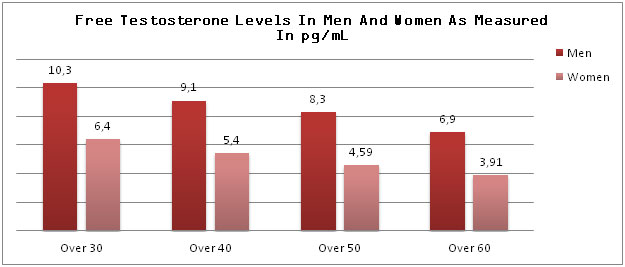Free testosterone
What Is Free Testosterone

What is free testosterone? Free testosterone is hormone that is not bound to any proteins within the blood; hence, making it “free.” Other testosterone that is not “free” is bound to sex hormone binding globulin proteins in the blood. Low free testosterone has been said to cause sexual problems.
Free testosterone levels can be read in blood tests and can be in normal range, too low or too high. Different clinics will have varying ranges as to what they determine to be “within normal range” for free testosterone levels. If levels are too low, replacement therapy can get them back to where they need to be to make a person look and feel their healthiest.
According to age, here are the averages ranges of what testosterone free levels should look like for men:
- From 30 to 40 years old: 10.3 pg/mL
- From 40 to 50 years old: 9.1 pg/mL
- From 50 to 60 years old: 8.3 pg/mL
- Over 60 years old: 6.9 pg/mL
According to age, here are the averages ranges of what normal free testosterone should look like for women:
- From 30 to 40 years old: 6.3 pg/mL
- From 40 to 50 years old: 5.4 pg/mL
- From 50 to 60 years old: 4.59 pg/mL
- Over 60 years old: 3.91 pg/mL
Men will need more testosterone in their bodies than women will, as shown in this breakdown. Here is a very accurate and average free testosterone levels by age chart that most clinics will use to determine if testosterone replacement therapy can be prescribed for a patient. Here you will be able to clearly see the difference of the male and female free testosterone level.

Low free testosterone levels are considered to be anything less than the numbers listed here.
High free testosterone levels are considered to be anything greater than the numbers listed here.
For optimal health, a person should have their levels remain consistently in the average range. Fluctuation will happen daily, from morning until night; however, great changes may cause negative symptoms to occur. If levels do get too low, we can help a patient of ours to increase free testosterone so that they can feel great again.
How To Increase Free Testosterone
The trick to how to increase free testosterone is to work with a reputable low T clinic and to follow your doctor’s prescription and treatment plan exactly as instructed to do so. In addition, learning healthy lifestyle habits to help with the natural increase of testosterone within the body from the testicles or from the ovaries is another way to increase this vital hormone.
Healthy lifestyle habits include:
- Getting proper sleep
- Eating nutritious foods
- Exercising appropriate amounts
- Keeping stress levels low
- Never smoking
- Keeping alcoholic consumption to a responsible amount
The first step to be able to get your prescription to reverse low free testosterone levels is to call a reputable and well thought of clinic to begin your discussion. This is the time to learn all about this kind of therapy, what are free testosterone levels and why is it important to keep them in normal range. You can ask any and all questions that you have concerning therapy with us and our advisors will answer all of the inquiries openly and honestly.
The more you know about free testosterone and how to raise low levels safely, the better your results from therapy will be. There are rarely any negative side effects when therapy is done correctly with medical supervision. With us, the benefits of treatment will almost always well outweigh any dangers (usually caused by misuse or an allergic reaction).
What Are The Benefits Of Having Normal Free Testosterone Levels
Here is a list of the benefits of having normal free testosterone levels in the blood:
|
|
|
|
|
|
|
|
|
|
|
|
|
|
|
|
|
|
|
|
|
|
|
|
|
|
|
|
|
|
|
|
|
|
|
|
|
|
|
|
|
|
|
|
|
|
Patients must be over 30 and must have a bona fide free testosterone deficiency in order to participate in therapy with us. The correct testing including blood work and a physical exam along with a medical history are mandatory before injections can be prescribed. Medical supervision will always go along with therapy, as well as clinical advisor support.
